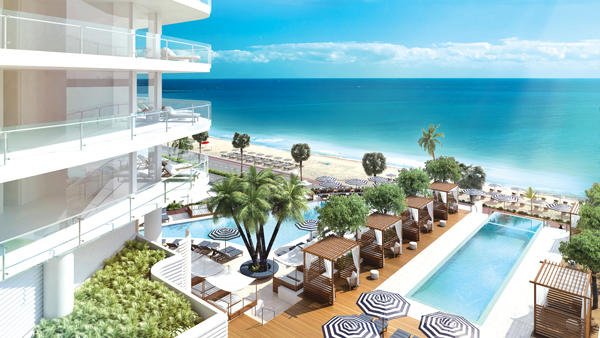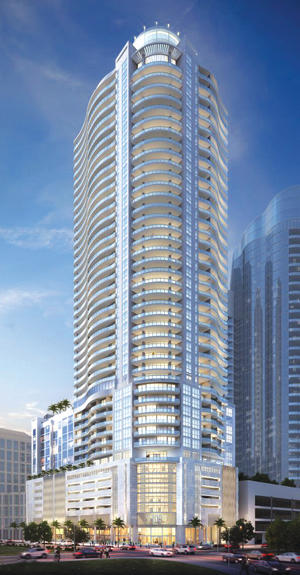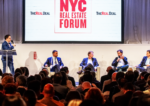Trending
Fort Lauderdale’s condo catch-22

Recently, developers have eagerly promoted downtown Fort Lauderdale and Las Olas Beach as the next frontier in South Florida’s luxury condo market. At the April groundbreaking for the Four Seasons Hotel and Private Residences Fort Lauderdale, the hospitality chain’s president, J. Allen Smith, gushed about bringing his upscale brand to the city’s beachfront, where it hopes to set “the standard for luxury lifestyle experiences.”
In the same month, Related Group Vice President Patrick Campbell boasted to Forbes that the company was having enormous success finding buyers for its posh Auberge Beach Residences & Spa Fort Lauderdale project, saying the 57-unit north tower was more than 95 percent sold and the south tower was 75 percent sold. “Our sales show demand is there for the project and product,” Campbell said.
Yet for all the positive spin, some brokers and builders are privately expressing a more sober outlook for the downtown Fort Lauderdale luxury condo market, according to experts interviewed by The Real Deal. In the first quarter of the year, the time luxury condos spent on the market in Fort Lauderdale was up nearly 22 percent, to 169 days, according to a recent Douglas Elliman report. The slow sales have made it harder for some developers to score construction loans and in turn break ground, they said.

Peggy Fucci, president of One World Properties, a Fort Lauderdale-based brokerage that handles sales for Paramount Fort Lauderdale Beach and 100 Las Olas, said the submarket tends to attract a more fickle customer base, which typically waits to see if a project actually breaks ground before signing a contract. She noted that sales for the 121-unit 100 Las Olas, which at 499 feet would be the tallest tower in Fort Lauderdale, have been slow since her firm was retained in December 2016 by developer Kolter, even though buyers are only required to put down a 30 percent deposit.
“The biggest challenge right now is that people want to see the developer is actually building,” Fucci said. “We are already reaching the 21st floor at 100 Las Olas and only have 30 percent sold. A majority of those sales have taken place in the last eight months because of the construction. People want to see it coming out of the ground.”
At Paramount Fort Lauderdale Beach, which opened in February, it took three years to sell out most of the building’s 95 units, Fucci said. Soon, One World and developers Nitin Motwani, Art Falcone and Dan Kodsi will close the sale on the last remaining unit, a two-story penthouse that is under contract for $9.9 million, she added.
Fucci said One World has found success targeting affluent buyers from Broward County’s western suburbs who are looking to downsize and be closer to the ocean. Yet it can take a considerable amount of time to get those buyers to sign a contract, she said: “Some of these people still have to sell their homes, so they don’t mind waiting to buy a condo.”
The snail’s pace of sales means it is taking longer for builders to obtain construction loans, Fucci said, adding, “The strength of the developer plays a big role in being able to break ground.”
Kolter, for example, secured a $25 million construction loan in March based on the company’s track record of delivering projects on time, despite the fact that the developer hasn’t hit the magic number of 50 percent sold, Fucci said.

100 Las Olas is about 30 percent sold.
Jack McCabe, a real estate consultant who does market analyses for South Florida developers, said some clients and their competitors are so antsy about supply outpacing demand in downtown Fort Lauderdale that — as in the case of 100 Las Olas — they have less stringent deposit requirements than in Miami. The hope is that lower deposits will help to lure international investors from Latin America who have traditionally been more interested in Miami-Dade.
“In downtown Fort Lauderdale, the condo projects are only requiring 20 and 30 percent down payments, while in Miami it is 50 percent,” McCabe said. “I think they are making it easier to buy in Fort Lauderdale because of concern that there are not enough foreign buyers to pick up the units that are being proposed.”
But Fort Lauderdale’s inventory is still a fraction of what is available in Miami’s urban core. The area including Brickell, the Miami River District and Edgewater had a total of 12,216 new construction units for sale from 2011 to 2017, compared to 1,411 in downtown Fort Lauderdale during the same period, according to the recently released ISG World 2018 Miami Report. Nearly half of the downtown Fort Lauderdale projects are boutique condo buildings with less than 50 units.
However, the ratio of unsold condos in downtown Fort Lauderdale compared to its neighbor to the south is much higher. In Miami’s urban core, 15 percent of new luxury condos built during this cycle are still on the market, while 46 percent of new luxury condos built in downtown Fort Lauderdale over the same period remain unsold, according to the ISG report.
Some luxury condo developers have opted to build rental apartments in Fort Lauderdale instead, like Property Markets Group, which is launching its first multifamily project downtown. The company plans to build two apartment towers with 1,200 units as part of a mixed-use project on the former site of Las Olas Riverfront. Half of the apartments will be microunits.
“With the general uncertainty in the market and rising interest rates, it is forcing a lot of people to rent versus buying,” said PMG principal Ryan Shear. “Homeownership is trending downward. We just felt multifamily was the better, safer entry into the Fort Lauderdale market.”
Brett Forman, CEO of Trez Forman Capital Group, which is financing construction of two downtown Fort Lauderdale apartment projects, said he believes the submarket is strong enough to absorb the units in the city that are currently on the market.
“Yes, there is going to be an imbalance for a short time, but it’s nothing catastrophic,” Forman said. “Fort Lauderdale is on a path of progress. You have Northerners migrating to the city, and then you have folks from the western suburbs who are tired of dealing with traffic congestion on a daily basis.”




